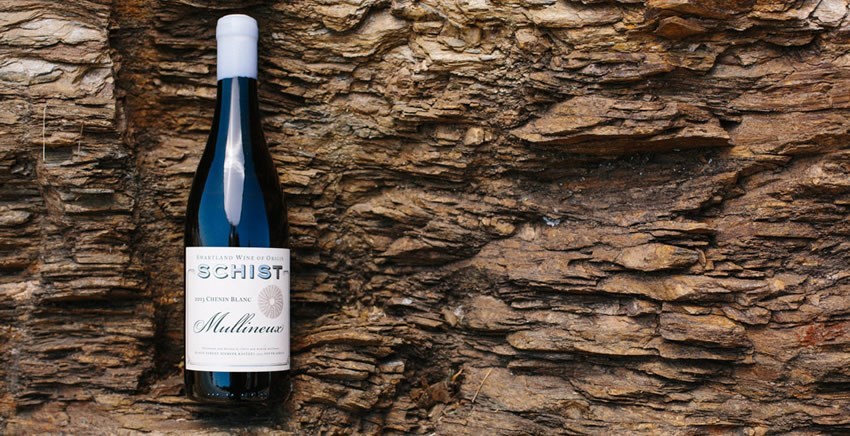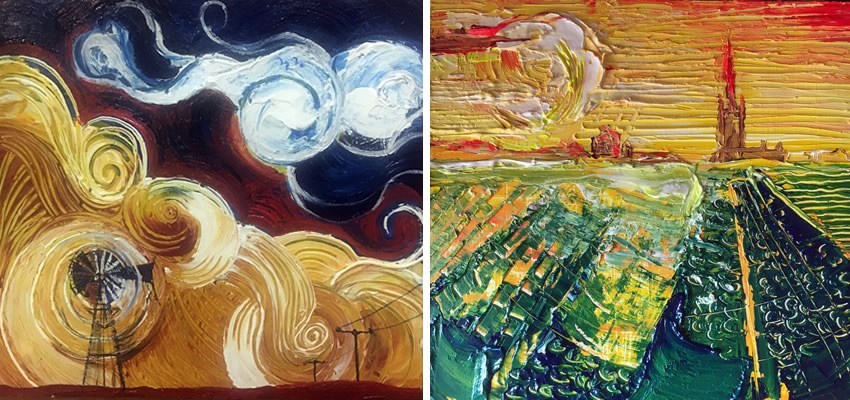“By whole cluster fermenting we hold up a magnifying glass to the soils types,” explains Andrea Mullineux of Mullineux & Leeu Family Wines on her method for approaching the vinification of the 2018 single-terroir Syrahs. I’m on my porch, she and Chris are in the Swartland. I’ve got dinky little bottles of the new releases to taste with them through the screen.
“The distinguishing differences between the wines are the tannins,” says the self-confessed ‘tannin nerd’. “So when fermenting I’m thinking about what the structure of the soil wants to give the wines. I’m the custodian of that, helping it through its life.”
Working with whole cluster syrah Andrea believes that the extraction needs to be gentle and natural ‘like a cup of brewing tea’. “If you let the tea leaves steep, the tannin, colour and flavour extract out naturally and in balance. If you squeeze those tea leaves, yes, everything is going to be more intense in colour and tannin, but it is going to be out of balance and probably quite harsh.”
She says she has the same approach in keeping the cap wet by using her own hands, by doing so she can feel resistance as well as cool or hot spots, helping her keep fermentation temperatures even. “Everything must be slow for a balanced natural extraction. I like to take my time to get the tannins through a large portion of the polymerization process during extended maceration. That way I can work with primarily large and older oak as aging vessels as I’m not looking for additional tannin from the oak itself.”
The syrahs coming from three different vineyards with three different soil types are named for the latter: Granite, Schist and Iron.
Calling up an image of the Granite vineyard Andrea says: “There are no straight lines in nature, and there shouldn’t be any straight lines in a vineyard.”
From my glass of Granite, a Provençal perfume rises, dried lavender flowers, tarragon, violets, black pepper. Angular, hewn from the Swartland’srocky heart with an acidity that races in. It’s easy to see why the Mullineuxs describe it as a ‘linear, ageing wine’. There is fruit, and it speaks of the white light of the sun, an intense purity. Strawberry-toned with juicy cherry and a coiled savouriness waiting to spring. Andrea describes the tannins as a stalactite, arching jaggedly across the palate.
“I always taste in shapes,” she says smiling. “Where the Granite has a linear tannin, the Schist is more square and blocky, it’s built on the palate. It’s giving you this presence.”
Precise and contoured, those blocky tannins frame the Schist’s weighty, opaque fruit. Damson plums skate along with blackberry and hedgerow. There’s a seductive smoky plushness here, sewn in with elegant, layered acidity. A cheek-tingling freshness and hit of spice on the finish show that every part of this wild ride has been carefully considered, a journey of reveals.

The Iron lets us know we’re not in Kansas anymore. The rich, red soil makes its presence known with a slick of metal like you bit your tongue, a rusty Marscape where tomatoes are grown. The space odyssey is grounded in notes of black olive tapenade, charcuterie spice, hedonistic, meaty, translating to faded velvet as it stretches across the palate in radiating swirls.
“Iron’s tannins are round,” says Andrea empathically, and I see what she means.
There’s a growing number of oenophiles who describe their tasting notes in a visual format, such as Master of Wine Sarah Heller. Heller creates vivid impressions of the wines she tastes, shaping them in digital collages in which she illustrates the body, acids and tannins of the wine as well as the aroma, colour, and flavour profile. (See on Instagram.)
For some winemakers this process of visualising a wine’s components helps them in the winery, as a comparison tool for different blends, vintages.The illustrations being more powerful to accurately describe a wine than terms that oft get repeated (fruit-forward, long finish etc). Oregon winemaker, Patrick Reuter for example is said to hand sketch the shape of his wines right from fermentation to maturation.
Local journo and artist, Samarie Smith paints her impressions of wines in oils, which resulted in an exhibition in 2010: My Love Affair with Wine. The show encapsulated her subjective associations with wines. Drawing inspiration from aromas like petrichor gave shape to a Karoo landscape, or the wet streets of Paris where she tasted her first Vouvray. Some paintings translate delicious layers of fruit found in a wine in textured and colourful impasto techniques. Others celebrate the winemaker's craftsmanship to capture terroir, or echo the nostalgia that a wine can evoke.
Comments Samarie: “As an artist, I felt compelled to give shape to these experiences, almost eternalising that moment. I am playing with verticals now, tasting them blind, visualising them in colour and forms, then painting them. Interested to see how vintage variations are translated this way. Warmer vintages will have warmer colours, angular acidities will have sharper, defined edges, grippy tannins will have more texture.”
One could say that the art of shape-tasting can be likened to the neurological condition of synaesthesia, where information meant to stimulate one of your senses arouses several, such as seeing numbers in colour; or when you associate someone’s name with a smell.

Art by Samarie Smith - left: Aromas like Petrichor inspired by Sauvignon Blanc, right: When Chardonnay captures the glistening gold of a balmy morning in France.
Shape-tasting though, is more of a learned practice than cognitive dissonance. Andrea agrees, a few days after the new release tasting I asked her to elaborate.
“When tasting wines people will often start with colour, move to the aroma, focus mostly on taste, touch on texture and tannin with a word or two, and mention something about the length. This approach is more about word association with our taste buds,” she explains.
“Any tasting note is subjective, so by offering other dimensions, there is a better chance that you are going to connect with your audience and create cross-definitions with their own vocabulary. For me, this is true with all of the elements but especially with textures and tannin. Texture is such an underrated element in the wine’s description, yet when people talk about a food that they like or don't like, most of the time it is ‘because of the texture’ whether it is the ‘sliminess of okra’ or the ‘silkiness’ of chocolate mousse, texture can make or break a palate experience.”
When it comes to tannins, a subject Andrea is admittedly obsessed with, shapes become even more important.
“Tannin and other phenols are the backbones to a wine and it is up to the winemaker to determine that it is balanced yet still showing a real sense of variety and place. It would be weird to have a soft and supple young Barolo for example.
“Tannins go hand-in-hand with other mouthfeel characters leading to shape descriptors for me, not to be confused with textural tannin notes like dusty or gravelly, but actual shapes such as: blocks, lines, hashtags, doughnuts, stalactites, apostrophes, spheres, pyramids…”
If visual tasting is a way to help cement to memory the way specific wines taste, before they ebb away on the river of time, then sign me up. I can call up those round tannins of the Iron as I write this, the Martian landscape of its flavour, and I don’t think I’ll ever forget it.